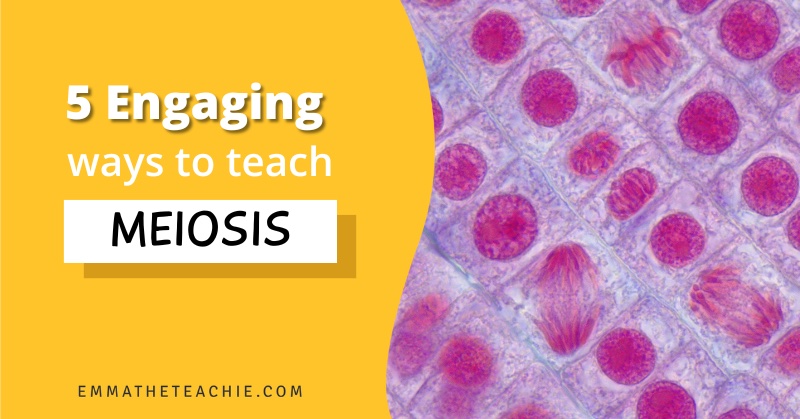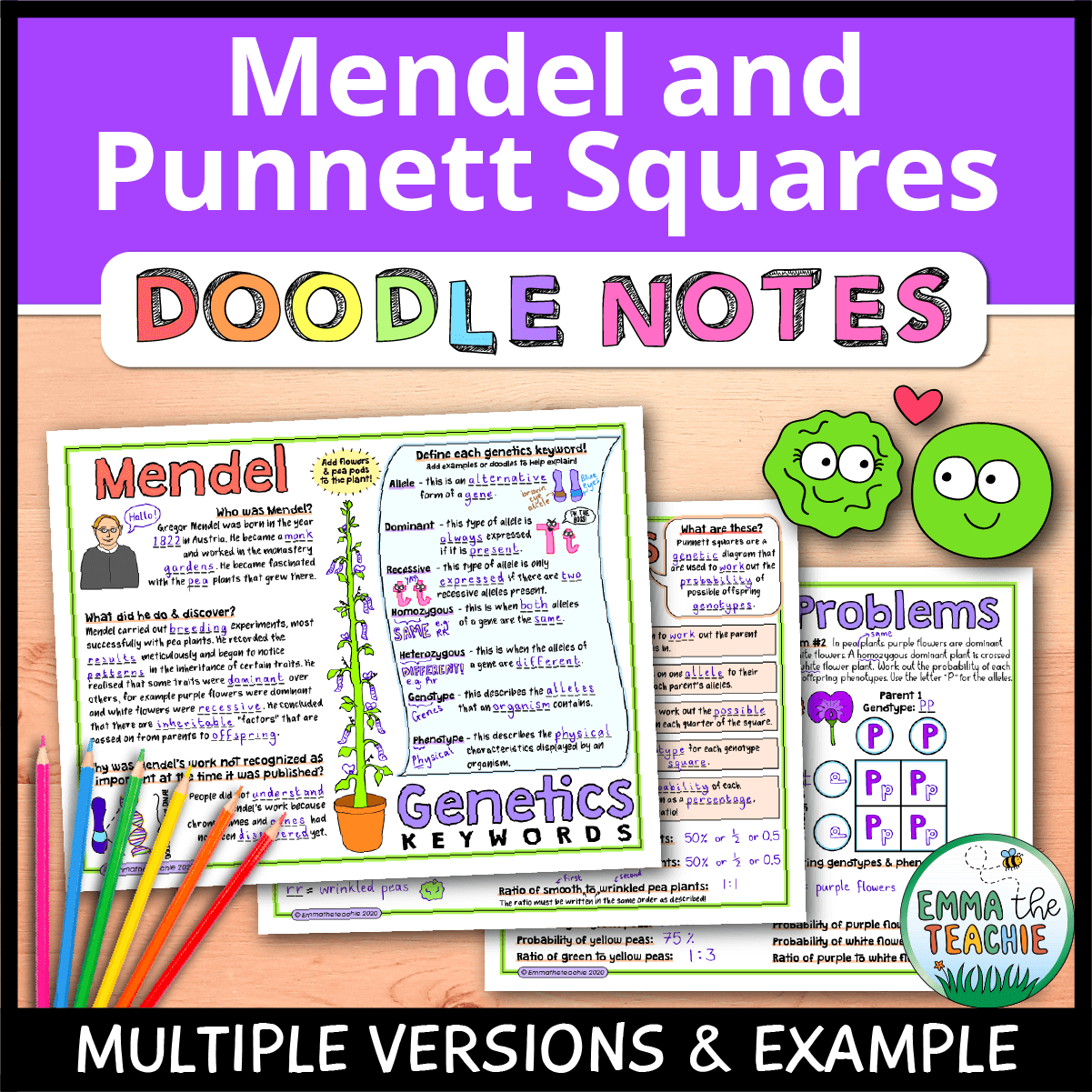
4 Ideas for Your Punnett Squares Lesson Activities
I love genetics and I love Punnett Squares. To me, they are like intricate puzzles that explain why we are the way we are.
I also feel like this is the biology topic that captivates students and truly gets them excited to learn.
They love figuring out traits like eye color, hair color, etc.
With all of that being said, teaching Punnett Squares can also be overwhelming.
What do I exactly mean by that? Well, I mean that there are so many resources and ideas out there that you may not know what is worth your time.
That’s where I want to help you!
I have narrowed down four great types of Punnett squares activities that you can easily incorporate into your lesson.
Let’s take a look, shall we?

1 – Use videos or reading passages about Mendel
It is impossible to teach about Punnett Squares without the mention of Gregor Mendel. I mean… he is the Father of Genetics.
I love using independent learning activities in lessons. For learning about Mendel, I like to give students a short reading passage, followed by a summary activity, like a word fill.
The image below shows the reading passage that is included in my Punnett Squares Google Slides activities.
Not only will students learn about Gregor Mendel’s personal past, but they will also understand how the principles of genetics came about. Once students have this basic understanding, they will be better equipped to apply their knowledge when practicing Punnett Squares.

Now… We all know that students would rather watch a video than read a passage. While I don’t believe that videos should replace reading, I do believe the two can supplement each other.
This is why I also couple the reading passage with a video in the classroom.
Simply put – students get the best of both worlds.
When assigning a video to your students, it’s important to watch it first to make sure it is appropriate and factual!
For Gregor Mendel, I have done this for you! Check out this TedEd video about Gregor Mendel.
I like this video because I find it to be engaging and informational for students.
One of my favorite ways to assign videos in my classroom is through EdPuzzle. When you upload or link a video into EdPuzzle, you can create questions throughout the video for students to answer.
In other words, the students have to pay attention to the video.
Want to know my favorite part? You can enable a feature that prohibits students from skipping the video and just answering the questions.
It’s fantastic and I highly suggest you try it out if you haven’t already.

2 – Inheritance keywords activities
Vocabulary is such an important part of learning about Punnett Squares.
If students don’t know the difference between heterozygous and homozygous, there’s going to be a major problem…
Since it is so important, I like to practice genetics vocabulary in a variety of ways.
One of the first activities I assign is for students to watch a YouTube video about the different inheritance keywords. I actually have my own YouTube video for this!
My Inheritance keywords video:
I like to share this directly with students so they can rewatch, pause, and change the speed. This lets them learn at a pace that works for them. Just make sure they have headphones!
Another way to reinforce inheritance vocabulary is through Google Slides activities.
By incorporating Google Slides activities, students’ learning will be interactive.
In my Mendel and Punnett Squares Google Slides activities, students read and digitally highlight a passage that breaks down important keywords. There are colorful doodles on the side to help explain these terms.
After students highlight the important terms, they use those definitions to complete more complex activities in the same Google Slides assignment.
E.g. drag and drop the genotype into the correct group – homozygous dominant, homozygous recessive, heterozygous.

After students have been introduced and practiced the genetics keywords for some time, I engage my students in a whole class review.
I have found whole class reviews work best for vocabulary review since it usually is a black-and-white concept.
A whole class review I like to engage my students in includes reading a statement about Punnett Squares vocabulary and students need to decide if the statement is true or false.
For example, I may say, “When an organism has two of the same alleles for a particular gene, we say it is heterozygous for that trait.” After I read the statement, the students would show what they think. There are a few ways to do this.
You can use:
- Thumbs up or down (up is true, down is false)
- Standing up or sitting down (up is true, down is false)
- Moving to sides of the room (left is true, right is false)
- Mini-whiteboards (true on one side, false on the other)
In this specific example, the answer is false. So, after students show what they think, we can engage in a short whole group discussion about why the statement is false.
These whole class reviews allow our students to demonstrate their understanding in a different way, which is more fun for them!

3 – Practice Punnett Squares Activities
Practice… Practice… Practice…
We have been told our whole lives that practice makes perfect! In order for students to truly understand Punnett Squares, they need to practice.
As students practice, they will become so much more confident in solving Punnett Squares.
There are so many ways to practice Punnett Squares in your classroom.

Here are my top 3 practice methods:
- Use mini-whiteboards – From my experience, students love using mini-whiteboards. Using mini-whiteboards makes the mundane task of practice problems much more exciting to students. When you do it as a whole class, it also lets us see very quickly who is struggling with the concept.
- Assign Google Slides activities – I usually use Google Slides to help students practice Punnett Squares. Check out my Mendel and Punnett Squares Google Slides where students have the ability to drag and drop phenotypes based on the Punnett Square. My students love the interactive nature of these activities! If you don’t have access to devices, paper practice problems also work really well. Tip: use a worksheet with pre-drawn Punnett Squares, as some students will spend WAY TOO LONG drawing the lines for a perfect Punnett Square.
- For struggling students – use instructional videos – some students will struggle with completing Punnett Squares. I give them an instructional video showing how to complete a Punnett Square – they can rewind and rewatch step-by-step as many times as they need to. These videos also provide quick access to a large variety of problems. I even recorded my own YouTube video to help students with Punnett Squares. Check out that video here!
4 – Punnett Squares Review Activities – Doodle Notes and Quizzes

Doodle Notes are a great review for Punnett Squares. Students can color code their Punnett Squares or make drawings to help relate the genotype to the phenotype.
My Mendel and Punnett Squares Doodle Notes also review the history of Gregor Mendel, as well as important vocabulary terms. Students will be more likely to remember and understand this information because they can connect the content with visual images.
Another great thing about Doodle Notes is their versatility!
You can use Doodle Notes as a note-taking tool, homework, review, or even substitute work.

Aside from Doodle Notes, another way to review Punnett Squares is through Boom Cards.
If you are not familiar with Boom Cards, they are interactive flashcards that students can use to review important information.
One of my favorite things about Boom Cards is the data tracking ability. I can see students’ scores, as well as how many times they played the deck and how long they spent on the deck. Note, data tracking is only possible with a premium account.
Boom Cards are self-checking. In other words, students will immediately know if they got the questions right or wrong. I’m a big fan of this! They can try again until they get the right answer.
I have created a set of Boom Cards to help students practice Punnett Squares, which can be found here.
You can check out a sample of my Punnett Squares Boom Card deck. When you click the preview link, you’ll be able to try the first four cards.

Lastly, you’ll want to quiz your students. Quizzes can be used formatively or as a summative assessment.
Whether you are giving students a formative quiz or summative quiz, Google Forms is a great tool to use.
First and foremost, Google Forms does the grading for you. Talk about easy.
Students also know their score right away, which can be useful when it is a formative assessment. Your students can then begin reviewing the specific topics that they are still struggling with.
I also really enjoy using websites like Kahoot and Quizizz as formative quizzes.
On these platforms, you can create your own questions or choose from a stocked library of pre-made quizzes, which will save you a ton of time.
Another great thing is you can use these formative quizzes as a whole class review or assign it to your Learning Management System and students can review them on their own time.

Which Punnett Squares Activities will you use?!
I hope you have found all of my suggestions for Punnett squares activities helpful.
I’ve intentionally picked activities that are low to no prep, and that are both rigorous and engaging for our students.
Take action: Scan through the list again, and decide which ones you will use for your lesson!
If you are interested in any of my resources for Punnett Squares, you can view them right here in my website shop:
I hope you have a wonderful day,






